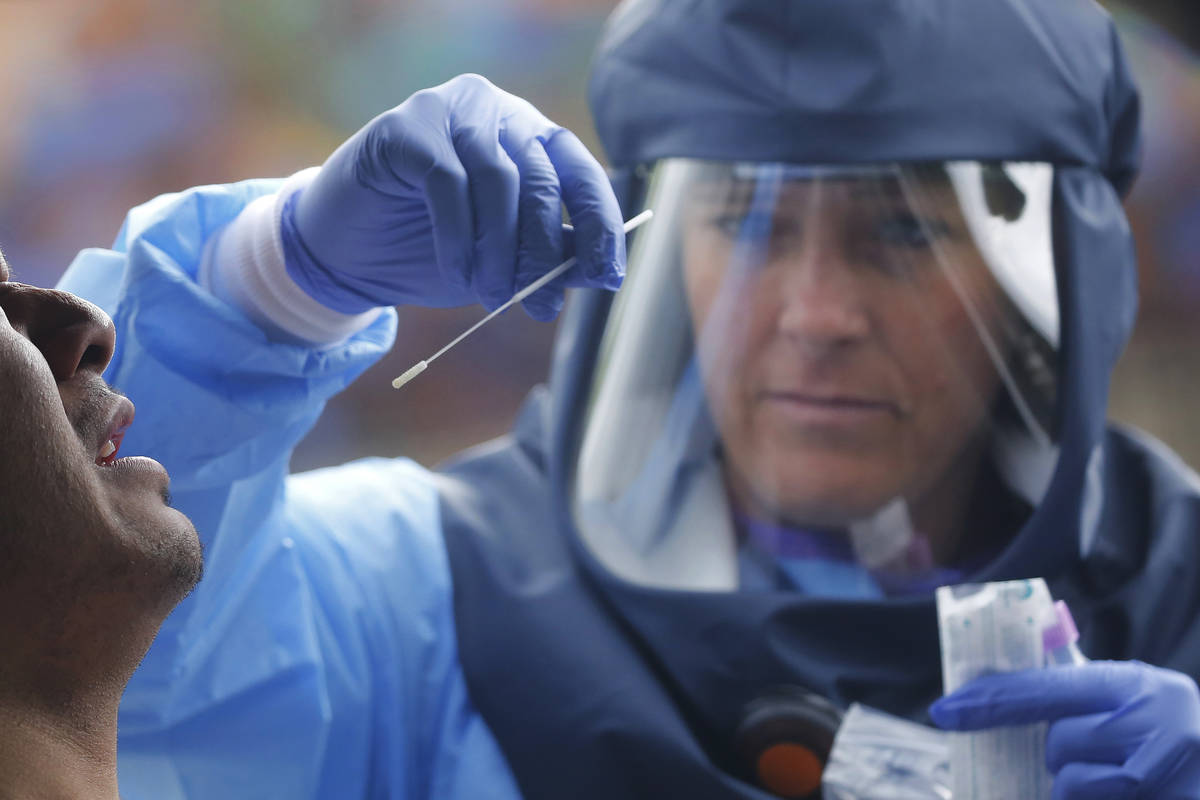Utah, Arizona see virus cases spike after reopening — could Nevada be next?
As Nevada reopens, two bordering states are grappling with their worst surge yet of novel coronavirus cases, just weeks after tighter restrictions were lifted.
Arizona has averaged more than 1,200 new cases per day for the past week, while Utah has averaged almost 350 new cases per day for the past week, according to data from The COVID Tracking Project published Thursday.
For both states, it’s a record high.
The surge in cases began in late May, about two weeks after the states began to reopen their economies. Utah state epidemiologist Dr. Angela Dunn said there’s a “clear” connection between the current spike in her state and the loosening of restrictions, as well as residents not abiding by voluntary recommendations, such as social distancing and wearing face masks.
“The virus is actually spreading in our region with more fury, when everyone was hoping that summer would bring a decrease in cases across the nation,” she said. “I think Arizona is showing us what is potentially to come in Utah.”
Utah allowed all businesses and dine-in restaurants in most parts of the state to reopen May 16. In the same week, Arizona Gov. Doug Ducey allowed his state’s stay-at-home order to expire, just days after allowing retail businesses, salons, gyms and dine-in restaurants to reopen. In Arizona, more than a third of the more than 31,000 infections have been identified since June 1.
Nevada has had a slower reopening and the true impact of rolling back the shutdown probably won’t be seen until later this month, said UNLV professor Brian Labus, a member of Gov. Steve Sisolak’s medical advisory team.
While the state’s restaurants, malls, retail stores, barbershops and salons began reopening May 9, it wasn’t until the end of May that Sisolak allowed other businesses, such as bars, pools, gyms and spas to reopen. Casinos began a phased-in reopening June 4.
“It can take up to two weeks for people to get sick and a few more days before they get tested,” Labus said. “The data we’re looking at now is telling us what happened about three weeks ago.”
The Silver State has seen its own recent uptick in cases, albeit to a lesser degree than its neighbors.
The seven-day average of new cases was 201 on Friday, the highest its been since the outbreak began in March, state data shows. Washoe County reported its largest single-day increase in cases, 61, on Thursday.
Tracking case growth by weeklong averages helps smooth out “meaningless” day-to-day fluctuations in data, Labus said, which are often affected by fewer people choosing to seek medical care on weekends.
Hospitalizations of infected Nevadans had also increased for seven consecutive days as of Friday.
But Nevada’s recent swell in cases is likely due to increased access to testing, not a “second wave” of coronavirus, said Caleb Cage, the state’s COVID-19 response director. Hospital occupancy rates have remained well within manageable levels, and the number of COVID-19 inpatients remains at about half its peak from early April.
More than 10,600 Nevadans have tested positive since the state’s outbreak was first identified in March. More than 7,800 of those people are estimated to have recovered and 462 had died as of Friday.
Coronavirus impact on Nevada explained through data
Cage said Nevada health officials are keeping an eye on what’s happening in Arizona and Utah and that health officials in all three states are in regular contact with one another.
“We know the virus doesn’t see any boundaries or borders,” he said.
Arizona’s largest hospital system, Banner Health, announced Monday that its number of COVID-19 patients on ventilators had quadrupled since mid-May. Chief Clinical Officer Dr. Marjorie Bessel told reporters last week the company’s hospitals were nearing their normal capacity for intensive care treatment.
On Tuesday, Banner announced that 42 percent of confirmed cases were people between the ages of 20 and 44. The company has attributed the increase in cases to the expiration of Arizona’s stay-at-home order.
State health officials did not answer multiple requests for comment, but a county health official in Phoenix said the rapid increase in new cases is causing alarm.
“We’re getting reports of almost 600 cases per day, compared with almost 200 cases per day two weeks ago,” Maricopa County Public Health spokeswoman Sonia Singh said Wednesday. “We know it’s not just more testing, but an increased spread.”
Nationally, 21 states are also seeing a jump in hospitalizations and cases since Memorial Day, according to an Associated Press analysis published this week. On Thursday, the U.S. had documented almost 2 million cases of COVID-19, with close to 113,000 deaths, according to the Centers for Disease Control and Prevention.
States may need to reintroduce shutdowns and the other mitigation efforts they’re now shedding if new cases rise “dramatically,” CDC deputy director Jay Butler said during a press conference Friday, CNBC reports.
The increases have led governors in Utah and Oregon to pause their reopening plans, The Hill reported Friday. On Thursday, Houston officials announced they were “close to” reimposing stay-at-home orders after a jump in cases.
Could tourism impact virus jump?
Surges in Arizona and Utah pose a unique problem for Southern Nevada because of their close proximity.
Residents of nearby states are likely to have family, business and vacations in Nevada. Arizona residents accounted for 10 percent of all Las Vegas tourists in 2018, according to the Las Vegas Convention and Visitors Authority.
Any visitors could be asymptomatic carriers of COVID-19, infectious but displaying no outward signs of the disease.
“We know that we’re going to have tourists coming to town that are potentially infected,” Labus said.
That’s why Nevada and its neighboring states have long-standing public health processes in place to alert each other if it’s discovered an infected individual traveled between them, said Julia Peek, a deputy administrator for the Division of Public and Behavioral Health. The state also plans to have 250 new disease contact tracers start working this weekend, tripling the previous number.
Traffic data shows that last weekend more than 120,000 vehicles traveled into Clark County from interstates connecting it to Arizona, Utah and California. That’s about 38,000 fewer than this time last year.
Labus said the risk of disease transmission is why the Nevada Gaming Control Board has required the state’s hotel-casinos to adopt a number of new safety measures. All licensed hotel-casinos must now screen hotel guests’ temperatures, limit gaming area occupancy and rearrange slot machines to allow for social distancing, among other requirements. Some have even gone so far as to install plexiglass shields between players seated at table games.
However, the greatest risk to Nevada remains resident-to-resident transmission, said Southern Nevada Health District acting chief health officer Dr. Fermin Leguen.
He and health officials in both Arizona and Utah agreed that COVID-19 could run rampant if people shirk social responsibilities such as wearing a face mask, washing their hands and maintaining 6 feet of distance from other people when possible.
“It doesn’t make a difference whether someone from Arizona arrives here with coronavirus. The same possibility of transmission is already here,” Leguen said. “This is a warning sign for all to make sure our community understands the value of social distancing. We shouldn’t ignore those preventative measures just because the economy is reopening.”
Contact Michael Scott Davidson at sdavidson@reviewjournal.com or 702-477-3861. Davidson is a member of the Review-Journal’s investigative team, focusing on reporting that holds leaders and agencies accountable and exposes wrongdoing. Follow @davidsonlvrj on Twitter.











































